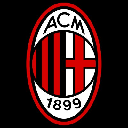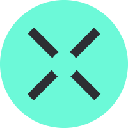-
 Bitcoin
Bitcoin $105,053.8967
0.28% -
 Ethereum
Ethereum $2,536.9103
0.49% -
 Tether USDt
Tether USDt $1.0004
0.01% -
 XRP
XRP $2.1735
1.51% -
 BNB
BNB $650.9659
-0.36% -
 Solana
Solana $146.0013
1.03% -
 USDC
USDC $1.0000
0.01% -
 Dogecoin
Dogecoin $0.1776
1.66% -
 TRON
TRON $0.2700
-1.20% -
 Cardano
Cardano $0.6367
0.08% -
 Hyperliquid
Hyperliquid $41.5154
4.36% -
 Sui
Sui $3.0303
1.00% -
 Bitcoin Cash
Bitcoin Cash $436.0395
5.03% -
 Chainlink
Chainlink $13.1926
-0.32% -
 UNUS SED LEO
UNUS SED LEO $9.0306
-0.41% -
 Stellar
Stellar $0.2595
0.37% -
 Avalanche
Avalanche $19.1528
0.37% -
 Toncoin
Toncoin $3.0008
1.46% -
 Shiba Inu
Shiba Inu $0.0...01218
4.24% -
 Hedera
Hedera $0.1597
4.06% -
 Litecoin
Litecoin $86.1907
2.88% -
 Polkadot
Polkadot $3.8078
-0.27% -
 Ethena USDe
Ethena USDe $1.0005
0.02% -
 Monero
Monero $315.3789
0.26% -
 Dai
Dai $0.9999
0.01% -
 Bitget Token
Bitget Token $4.5446
0.46% -
 Pepe
Pepe $0.0...01114
4.48% -
 Uniswap
Uniswap $7.3261
1.15% -
 Pi
Pi $0.5867
5.21% -
 Aave
Aave $276.8268
-2.40%
Which is the cheapest way to convert USDT to SOL or ETH?
For large-volume trades, OTC brokers offer competitive fees, while decentralized exchanges are more cost-effective for smaller conversions, with fees as low as 0.1% per trade.
Dec 17, 2024 at 12:51 pm
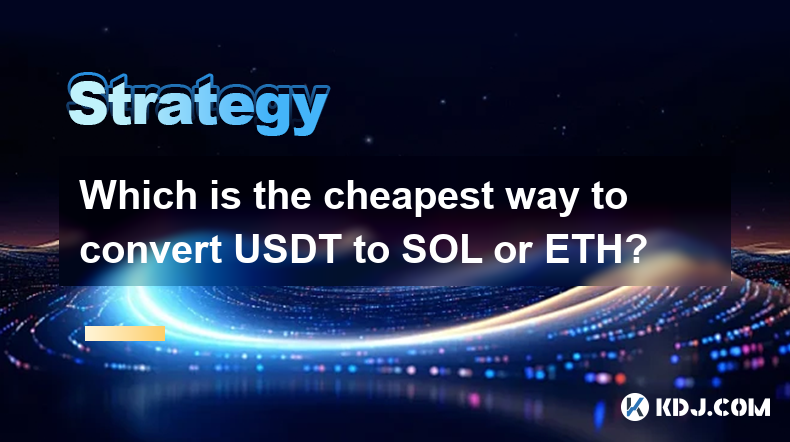
Key Points
- Compare the fees associated with different methods of converting USDT to SOL or ETH.
- Explore the benefits and drawbacks of each conversion method.
- Identify the most cost-effective and convenient option for your specific needs.
Which is the cheapest way to convert USDT to SOL or ETH?
Centralized Exchanges (CEXs)
Pros:
- User-friendly and accessible to beginners.
- Offer a wide range of cryptocurrencies and trading pairs.
- Provide liquidity for quick and easy transactions.
Cons:
- May charge high fees for deposits, withdrawals, and trading.
- Can be vulnerable to hacks and security breaches.
Fees:
- Deposits: Free or low fees (e.g., Binance: 0.01 USDT)
- Withdrawals: Varies depending on the exchange (e.g., Coinbase: 5.50 USDT for SOL)
- Trading fees: Usually around 0.1% of the trade value
Decentralized Exchanges (DEXs)
Pros:
- Non-custodial, offering full control over your assets.
- Lower trading fees and minimum transaction amounts.
- Provide access to a broader range of altcoins and decentralized finance (DeFi) projects.
Cons:
- Can be more complex and less user-friendly than CEXs.
- Limited liquidity may result in price volatility and slippage.
Fees:
- Gas fees for blockchain interactions (e.g., Ethereum: ~20-30 GWEI per transaction)
- Trading fees: Usually around 0.1% of the trade value
Peer-to-Peer (P2P) Marketplaces
Pros:
- Offer greater anonymity and control over transactions.
- Allow for negotiation and potentially lower fees.
Cons:
- Can be time-consuming and require manual negotiation with counterparties.
- Counterparty risk exists, as transactions are not guaranteed.
Fees:
- May vary depending on the marketplace and the counterparty's terms (e.g., Bisq: 0.05% of the trade value)
OTC Brokers
Pros:
- Offer high liquidity and quick settlement for large trades.
- Provide personalized service and customized pricing.
Cons:
- Usually accessible only to high-volume traders.
- Fees can be higher than other methods.
Fees:
- Varies depending on the broker and the trade size (e.g., B2C2: ~0.1% of the trade value)
Additional Factors to Consider
- Volume: High-volume transactions may benefit from OTC brokers or CEXs with lower fees on larger trades.
- Timing: Conversion times can vary depending on the method used and blockchain conditions. Consider your time constraints when selecting a conversion method.
- Security: Prioritize exchanges and platforms that implement robust security measures to safeguard your funds.
FAQs
- What is the minimum amount I can convert?
The minimum amount varies depending on the conversion method and platform. Some DEXs and P2P marketplaces may have no minimums, while CEXs may impose minimum deposit or trading requirements.
- How long does it take to convert USDT to SOL or ETH?
Conversion times can range from a few minutes on CEXs with quick order execution to several hours or days on DEXs due to network congestion or manual negotiation in P2P marketplaces.
- What are the risks involved in converting USDT to SOL or ETH?
Risks include exchange hacks, price volatility, counterparty risk in P2P markets, and potential loss of funds due to insufficient security measures.
- Is it better to convert USDT directly to SOL or ETH, or use USDT to buy BUSD or USDC first?
Using a stablecoin as an intermediate step can sometimes lead to lower trading fees, but this depends on the specific exchange and market conditions. Compare the fees for both options before making a decision.
- What is the most cost-effective way to convert USDT to SOL or ETH with large trade volumes?
OTC brokers typically offer the most competitive fees for high-volume trades.
Disclaimer:info@kdj.com
The information provided is not trading advice. kdj.com does not assume any responsibility for any investments made based on the information provided in this article. Cryptocurrencies are highly volatile and it is highly recommended that you invest with caution after thorough research!
If you believe that the content used on this website infringes your copyright, please contact us immediately (info@kdj.com) and we will delete it promptly.
- Rexas Finance (RXS), Sui (SUI), Shiba Inu (SHIB), and Hedera (HBAR): 4 Cryptos to Watch in 2024
- 2025-06-14 21:50:12
- As Over $90 Billion in TVL Remains Untapped, a New Generation of Crypto Companies Emerges
- 2025-06-14 21:50:12
- Mutuum Finance (MUTM) Pre-Sale Raises $7.3M Awaiting 20% Cost Increase to $0.03
- 2025-06-14 21:45:12
- USD/CAD Depreciates as US Dollar Remains Subdued
- 2025-06-14 21:45:12
- Tariff Tensions Reinforce JPY Safe-Haven Appeal
- 2025-06-14 21:40:13
- President Trump's upcoming 100-day speech has attracted great attention in the cryptocurrency field.
- 2025-06-14 21:40:13
Related knowledge

Cryptocurrency K-line chart technical analysis manual: Learn these methods to increase your chances of making a profit
Jun 11,2025 at 11:21pm
Understanding the Basics of K-line ChartsK-line charts, also known as candlestick charts, are one of the most widely used tools in cryptocurrency trading. Each K-line represents a specific time period and provides information about the open, high, low, and close prices during that interval. The body of the candle shows the relationship between the openi...

The Importance of K-line Chart Analysis in Cryptocurrency Trading: From Theory to Practical Cases
Jun 11,2025 at 04:56pm
Understanding the Basics of K-line ChartsK-line charts, also known as candlestick charts, are a visual representation of price movements over specific time intervals. Each K-line encapsulates four critical data points: the opening price, closing price, highest price, and lowest price within a given timeframe. These charts originated in Japan during the ...

Cryptocurrency K-line Chart Interpretation Guide: How Novices Can Quickly Master the Basics of Technical Analysis
Jun 10,2025 at 08:56pm
Understanding the Basics of K-line ChartsK-line charts, also known as candlestick charts, are one of the most widely used tools in cryptocurrency trading for analyzing price movements. Each K-line represents a specific time period and shows the opening, closing, high, and low prices during that interval. For novices, grasping how to read these elements ...
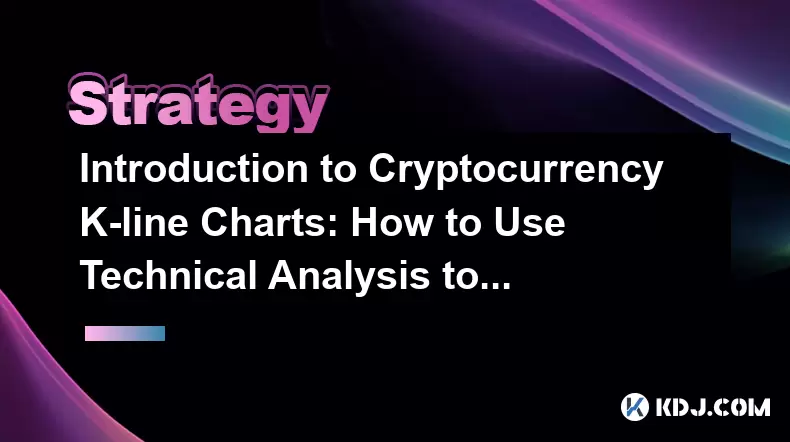
Introduction to Cryptocurrency K-line Charts: How to Use Technical Analysis to Optimize Trading Decisions
Jun 12,2025 at 03:56pm
Understanding the Basics of K-line ChartsK-line charts, also known as candlestick charts, are one of the most essential tools used in cryptocurrency trading. Originating from Japan, these charts visually represent price movements over specific time intervals. Each candlestick displays four key pieces of information: the opening price, closing price, hig...
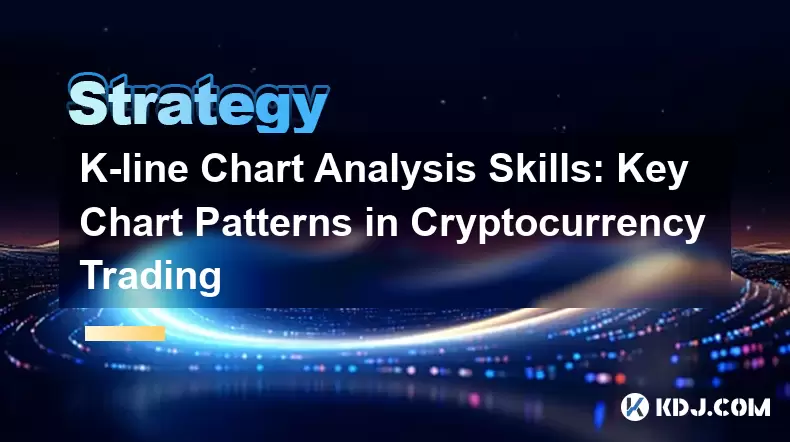
K-line Chart Analysis Skills: Key Chart Patterns in Cryptocurrency Trading
Jun 13,2025 at 10:21am
Understanding the Basics of K-line Charts in Cryptocurrency TradingK-line charts, also known as candlestick charts, are essential tools for analyzing price movements in cryptocurrency markets. Each candlestick represents a specific time frame and provides information about the open, high, low, and close (OHLC) prices during that period. In crypto tradin...
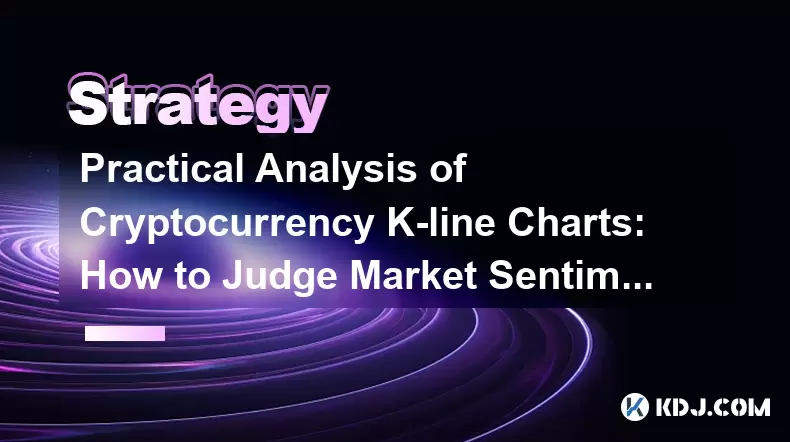
Practical Analysis of Cryptocurrency K-line Charts: How to Judge Market Sentiment through Charts
Jun 10,2025 at 09:42pm
Understanding the Basics of Cryptocurrency K-line ChartsCryptocurrency K-line charts, also known as candlestick charts, are essential tools for analyzing price movements in the crypto market. Each candlestick represents a specific time frame, such as 1 minute, 5 minutes, or even daily intervals. The structure of a K-line includes four key data points: o...

Cryptocurrency K-line chart technical analysis manual: Learn these methods to increase your chances of making a profit
Jun 11,2025 at 11:21pm
Understanding the Basics of K-line ChartsK-line charts, also known as candlestick charts, are one of the most widely used tools in cryptocurrency trading. Each K-line represents a specific time period and provides information about the open, high, low, and close prices during that interval. The body of the candle shows the relationship between the openi...

The Importance of K-line Chart Analysis in Cryptocurrency Trading: From Theory to Practical Cases
Jun 11,2025 at 04:56pm
Understanding the Basics of K-line ChartsK-line charts, also known as candlestick charts, are a visual representation of price movements over specific time intervals. Each K-line encapsulates four critical data points: the opening price, closing price, highest price, and lowest price within a given timeframe. These charts originated in Japan during the ...

Cryptocurrency K-line Chart Interpretation Guide: How Novices Can Quickly Master the Basics of Technical Analysis
Jun 10,2025 at 08:56pm
Understanding the Basics of K-line ChartsK-line charts, also known as candlestick charts, are one of the most widely used tools in cryptocurrency trading for analyzing price movements. Each K-line represents a specific time period and shows the opening, closing, high, and low prices during that interval. For novices, grasping how to read these elements ...

Introduction to Cryptocurrency K-line Charts: How to Use Technical Analysis to Optimize Trading Decisions
Jun 12,2025 at 03:56pm
Understanding the Basics of K-line ChartsK-line charts, also known as candlestick charts, are one of the most essential tools used in cryptocurrency trading. Originating from Japan, these charts visually represent price movements over specific time intervals. Each candlestick displays four key pieces of information: the opening price, closing price, hig...

K-line Chart Analysis Skills: Key Chart Patterns in Cryptocurrency Trading
Jun 13,2025 at 10:21am
Understanding the Basics of K-line Charts in Cryptocurrency TradingK-line charts, also known as candlestick charts, are essential tools for analyzing price movements in cryptocurrency markets. Each candlestick represents a specific time frame and provides information about the open, high, low, and close (OHLC) prices during that period. In crypto tradin...

Practical Analysis of Cryptocurrency K-line Charts: How to Judge Market Sentiment through Charts
Jun 10,2025 at 09:42pm
Understanding the Basics of Cryptocurrency K-line ChartsCryptocurrency K-line charts, also known as candlestick charts, are essential tools for analyzing price movements in the crypto market. Each candlestick represents a specific time frame, such as 1 minute, 5 minutes, or even daily intervals. The structure of a K-line includes four key data points: o...
See all articles


















